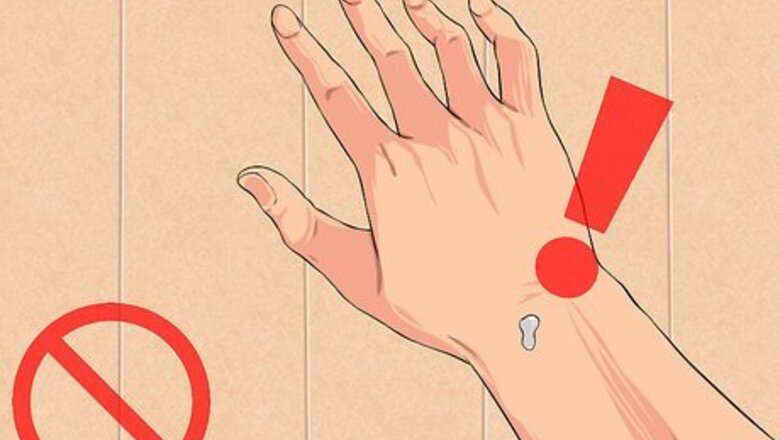
views
Removing E6000 From Skin
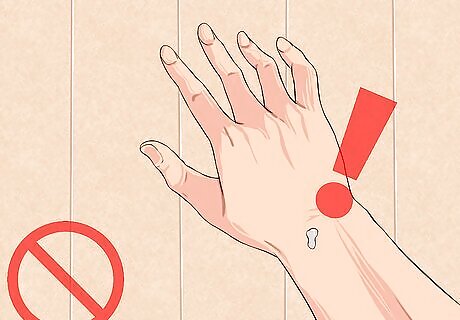
Don’t panic if the glue bonds to your skin. Some industrial-strength adhesives bond in seconds. E6000 takes longer to “cure” at about 24 hours, but will still be tacky within minutes. Don’t panic if you realize that you have accidentally glued your skin or two fingers together. You can try to weaken the bond with solvents or even warm water. Don’t try to pull your fingers apart if they are glued together. You may tear the skin. If you have accidentally applied E6000 to your lips, eyelids, eyeballs, or other sensitive body parts, seek immediate medical attention.

Soak the affected area in warm, soapy water. Warm water and soap will loosen the bond and is less likely to aggravate your skin than chemical solutions. Fill a basin with warm water, adding soap and working it into a lather. Soak your fingers, hands, or whatever area has bonded until the glue weakens. This may take 15 minutes or more. Then, begin to rub the area gently back and forth. Continue rolling it until the bond breaks. Again, do not try to pull the glue bond apart. You can also use a tool like a pencil, spatula, or spoon to jimmy the glue loose.
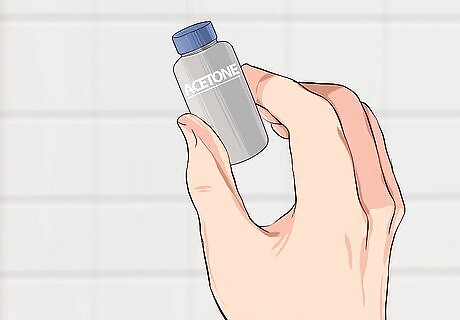
Use acetone or nail polish remover, alternately. Mild solvents will dissolve adhesives like E6000 and superglue and should work in case simple soap and water fail. You should be able to find acetone in common household products like nail polish remover or paint thinner. Take a Q-tip or cotton swab and dab it in a small amount of acetone. Then, wet the glue where it has bonded to your skin. The solvent should soften the glue. Begin to work the glue back and forth once it is loose and gently peel the skin away from the glue, without pulling. Acetone can irritate the eyes, skin, and lungs. Use it in a well-ventilated area and avoid swallowing or bringing it into contact with your eyes. Wash your hands with soap and water after you have removed the glue. Acetone will also discolor fabrics and damage finishes. Take care to keep it away from your clothing and surfaces like countertops and floors.
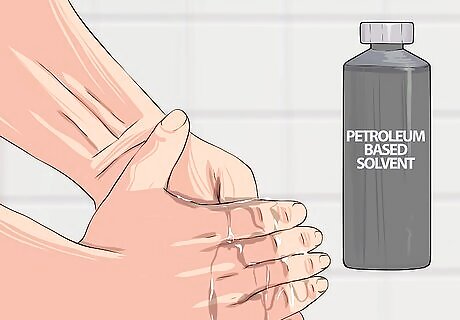
Wash the area with a petroleum-based solvent. If soap and water and acetone fail, or are not available, try a petro-based cleaning product like Goo-Gone. Goo Gone contains methyl alcohol but also the solvents toluene and acetone, so it should be able to dissolve even heavy-duty glues. Apply the liquid solvent to the affected area with a cotton swab or blot it with a cloth. Wait one or two minutes, and then start to work the glue back and forth. Use an exfoliating scrub if the liquid is not enough. As always, gently peel the skin away from the glue rather than pulling. All the ingredients of Goo Gone are toxic and irritants. Use the solvent in a well-ventilated area and avoid swallowing or bringing it into contact with your eyes.
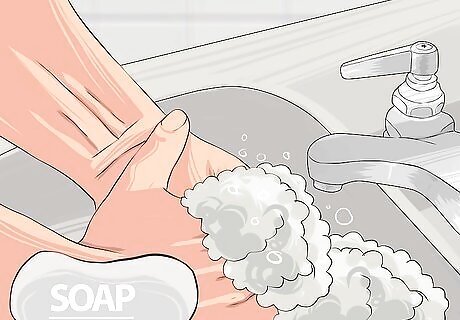
Wash your skin thoroughly. Nail polish remover, paint thinner, and petroleum solvents are toxic chemicals and will irritate your skin with prolonged contact. Make sure to remove them once the glue bond is dissolved. Flush the affected area with soap and water for at least 15 minutes. Consider applying lotion after you’ve washed, in order to moisturize and repair your skin.
Removing E6000 from Everyday Objects
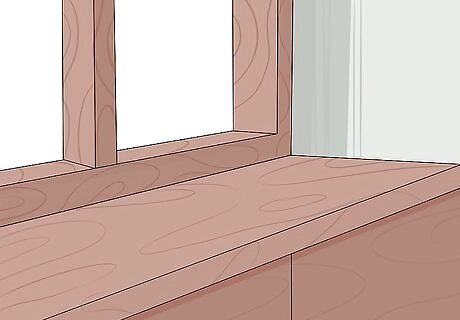
Prepare the area. E6000 glues are serious adhesives. The chemicals and solvents that best dissolve them are quite harsh and need care, as well. Make sure that you set up and take all the proper precautions. Find a well-ventilated area outdoors to work, like an open garage. A concrete floor is ideal but you can also place your bonded item on top of old newspapers. Wear rubber gloves and a mask and protect other areas of your body by wearing goggles and a thick layer of clothes. Acetone, naphtha spirits, and petroleum based solvents are highly flammable. Make sure that you do not use them near sparks or open flames. Always read the manufacturer’s instructions and warning label before using a toxic product.
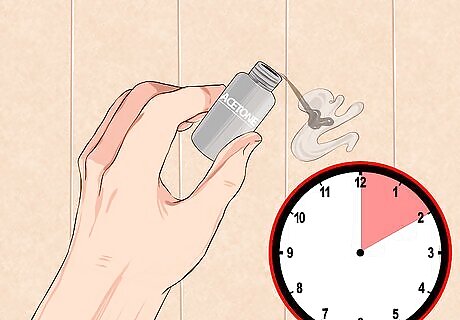
Apply acetone nail polish remover or naphtha spirits to the glue. Acetone and naphtha spirits are both solvents that will soften and start to dissolve E6000 bonds. Wet a rag or a cotton ball with either of these liquids and apply it liberally to the glue. These solvents are strong enough to damage some substances. Do a small trial run before removing the glue if you are worried about the object. Let the solvent set for 10 to 30 minutes. Since these chemicals can give off fumes, leave and return to see if the glue is removed. Use a soft cloth to blot the area and see if any glue is still left. Repeat the treatment if needed. Then, wash the item with dishwashing detergent and water to remove the glue and the solvent chemicals.
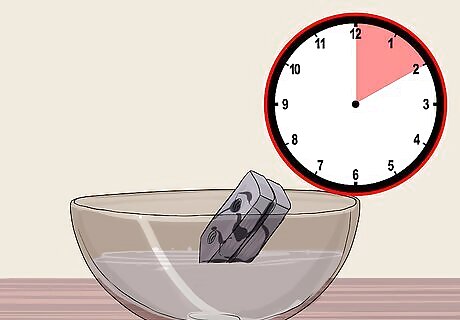
Submerge the item in petroleum, alternately. For very heavy duty items, like metal car parts, you may be able to completely submerge the glue in gasoline or a similar petro-based substance. These chemicals are effective solvents but, obviously, should be used with extreme caution. Fill an appropriately sized bucket with gas. Be careful to avoid spillage when filling the bucket, as pools of fuel can pose a fire hazard. Submerge the item in the bucket for 10 to 30 minutes while the glue loosens and dissolves. Keep flames and fire well away from the area.
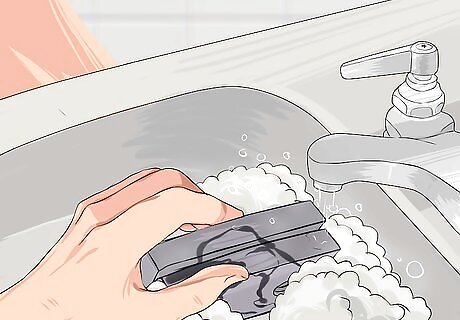
Try to remove the glue. Carefully remove the item from the bucket of gasoline. Soak the item for another 30 minutes or more if the glue is still intact. Rinse the item using mineral spirits or other cleaning products. Then safely dispose of all water, oil and spirits, and solvents. NEVER pour these down sewers or drains and NEVER throw them in the garbage. Instead, contact your local environmental protection agency or municipal government to find out the best way to dispose of hazardous wastes.
Removing E6000 from Fabrics and Hard Surfaces

Use acetone and an old tooth brush on fabric. Chances are that E6000 or any other industrial strength glue will ruin clothing, either because you won’t be able to remove it entirely or because the fabric will be discolored or damaged in removal. Try acetone if you want to keep the item, however. Find an old tooth brush. Then, using an applicator like a cotton swab, dab the glue with acetone. Brush the bonded glue with the tooth brush to begin removing the adhesive. Reapply the solvent and brush several times to erode the glue. Work on both sides of the fabric, if need be. You may not be able to entirely remove the glue. When done, remove the acetone by washing the fabric.

Soften glue on hard surfaces. Hard surfaces like tables, countertops, and floors can take a more aggressive approach. First, choose the right solvent for your surface. You do not want to damage the surface with too powerful a chemical. Goo Off, for example, contains mainly acetone and will dissolve plastic, laminate, and Formica surfaces. Test a small and inconspicuous area of your surface beforehand to prevent widespread damage. Once you are sure that the solvent will not harm the surface, apply it liberally to the glue.
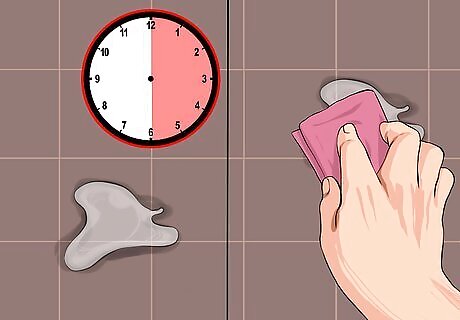
Abrade the surface. Let the solvent sit for 15 to 30 minutes. Then, begin to abrade the softened glue with whatever mechanical means are at hand. Repeat this process until the glue is gone. You can use a heavy cloth or rag, a wire brush, sandpaper, or a tool like a screwdriver to abrade the glue, depending on the surface. For especially hard surfaces, it may be possible to scrape off the glue with a utility knife or razor blade. Be careful not to cut yourself. Unfortunately, abrasion may scratch or damage the surface while you are removing glue. A hardwood floor may need to be sanded and refinished, for example.




















Comments
0 comment